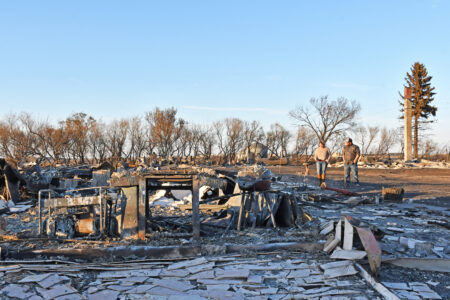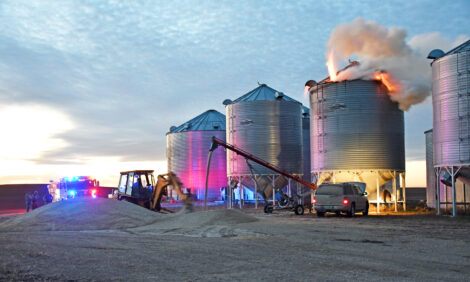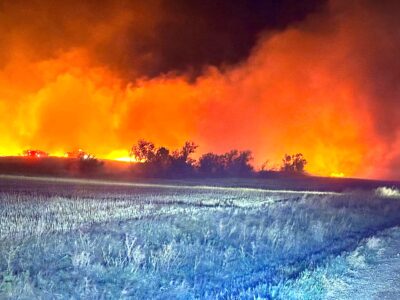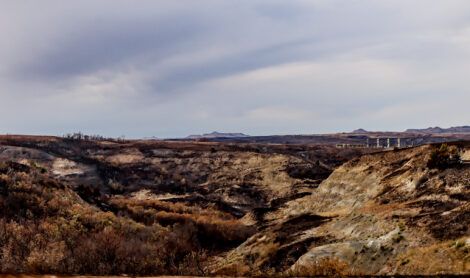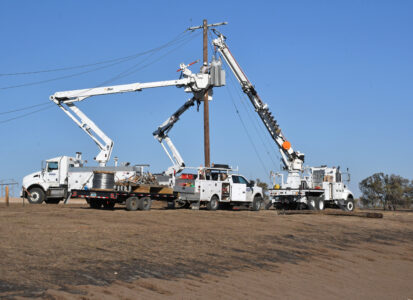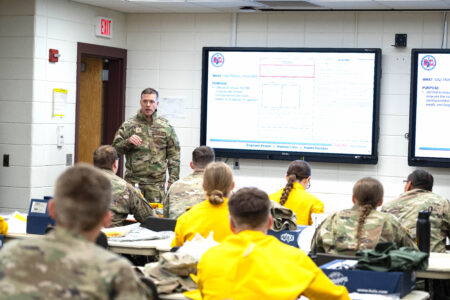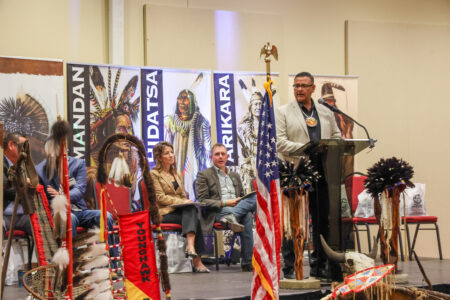One year ago: Historic wildfires
Northwestern North Dakota remembers those impacted, lost
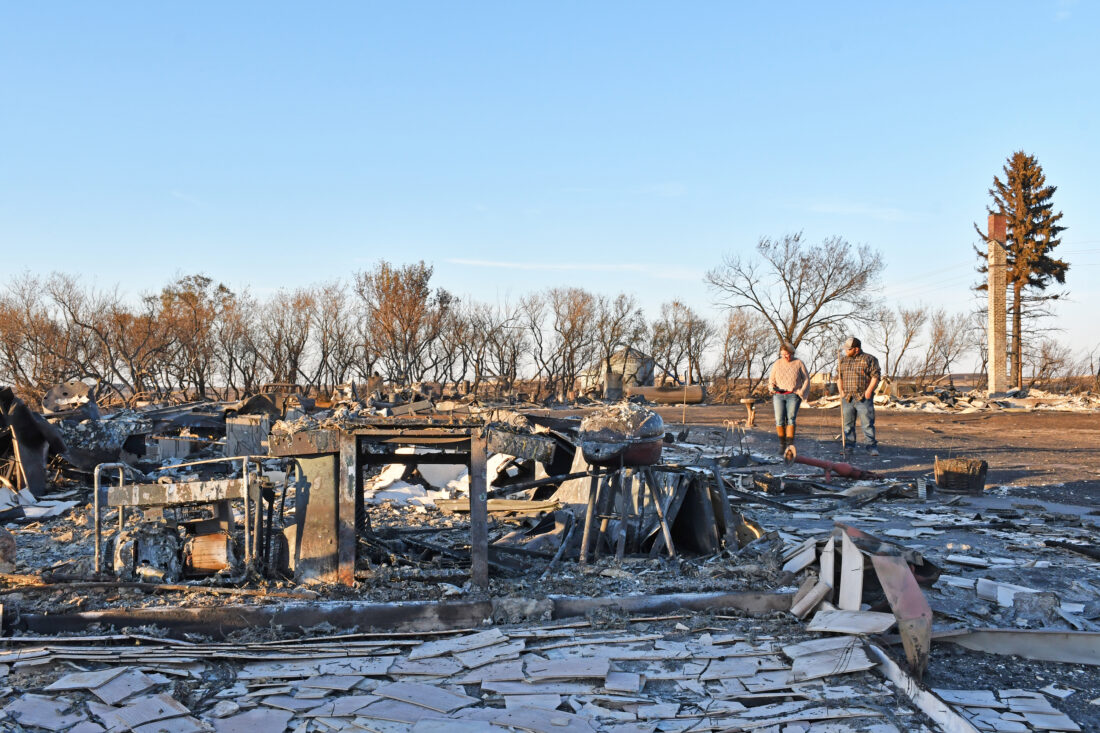
Nicole Koch and William Allen look over her grandfather Holte’s fire-ravaged farmstead mid-way between Tioga and Ray on Monday, Oct. 7, 2024. The ruins in the foreground were his new modular home, and an older remodeled house stood where the fire-scorched chimney still stands near the pine tree on the right side of the photo. Photo by Roger Riveland.
Historic wildfires that swept through northwestern North Dakota a year ago tested the solidarity of local communities and the resolve of its first responders and found them unwavering.
Local, regional, federal and tribal firefighters, along with emergency responders, battled several wildfires from Friday, Oct. 4, though Sunday, Oct. 6, 2024. A red flag warning had been issued for most of western and central North Dakota through Saturday, Oct. 5, with wind speeds of 35-45 mph and gusts of 75 mph or more.
Johannes Nicolaas Van Eeden, 26, of South Africa, who was about to return home to his wife for the birth of their daughter, was overcome by smoke inhalation while driving in the Tioga area and became the first casualty of the fires. Sgt. Coby Hubble of the North Dakota Highway Patrol was awarded a distinguished service medal for his efforts to save van Eeden and others on Oct. 5.
A second death occurred when Edgar Coppersmith, 47, Tioga, succumbed to critical injuries. Eight other people were injured in the fires according to the Williams County Sheriff’s Office.
A public event to remember the wildfires was held in Watford City this past August. Among the impacted landowners, community leaders and first responders who attended was van Eeden’s widow, Anke Van Eeden.The Watford City event included the showing of a 30-minute video created by the North Dakota Department of Emergency Services (NDDES). The video, “Historic Oct. 5 Wildfires” is playing at the North Dakota Heritage Center through this month and also can be found online.
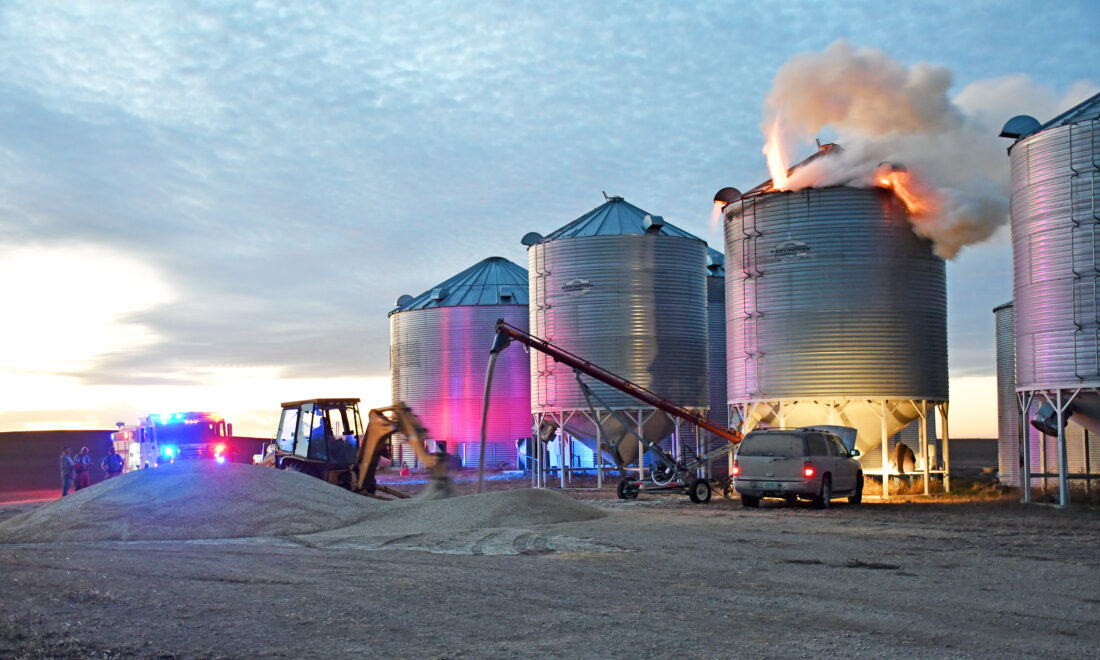
A hopper bottom bin full of safflower burned late into the evening three miles west of Ray on Monday, Oct. 7, 2024. The bin, belonging to Tom Wheeler, burns while he and others auger out the contents to save the good grain. The Ray Fire Department stands by to extinguish the fire in the bin once the good grain is removed. The fire was believed to have started by embers entering through the vents on the bin. Photo by Roger Riveland.
“We knew we needed to try to tell the story of this historical and tragic event in our state,” said Alison Vetter, Strategic Communications chief with NDDES. “Especially to bring to light the pieces that often go unseen, like the behind-the-scenes coordination. As we went along, we realized that capturing stories can be a way to honor a person’s experience and perspective. It was profoundly impactful for us putting this piece together and we hope that by sharing we can help people – wherever they are on their journey – towards the full physical, financial, mental and emotional recovery.”
Firefighters at Arnegard who reported the first fire about 2 a.m. quickly needed to call in for more resources. Additional fires at Charleston and Grassy Butte followed on the heels of the Arnegard fire. Three major fire sectors eventually developed – the Williams County fire and Elkhorn and Bear Den in McKenzie County.
Firefighters from multiple departments across Billings, Dunn, Williams and McKenzie counties responded, along with crews from neighboring communities in Montana. Firefighters from Fort Berthold also were called into action.
Still, fires continued to spread, rolling right through 150 feet of ground cleared as fire guard, according to one firefighter’s account in the video. Visibility was zero due to smoke, and communication was difficult.
“I can’t even envision a more dangerous scenario. When you talk to the firefighters, it was spooky for them,” said State Forester Tom Claeys in the video.
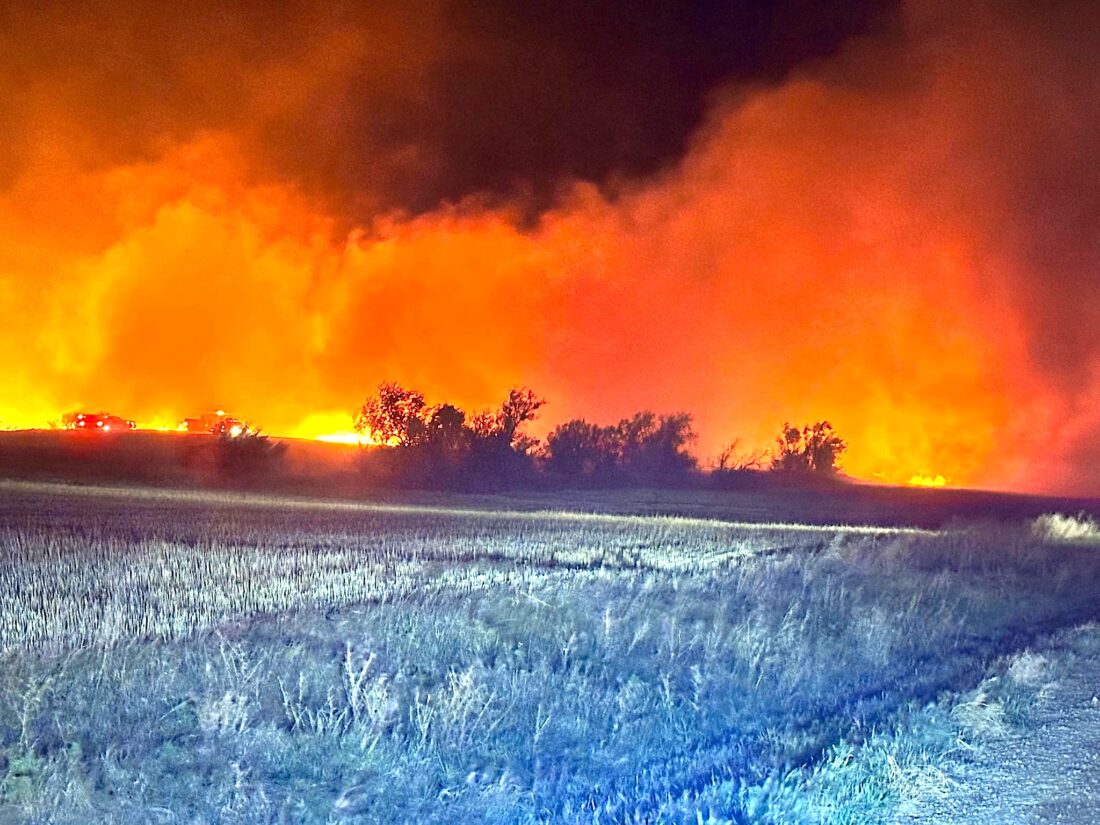
Fire burns acreage near Arnegard on Saturday, Oct. 5, 2024. Photo courtesy Arnegard Fire Protection District and Badlands Search & Rescue Service.
Meanwhile, the markers on the map showing the fire locations continued to grow.
“At times, it was overwhelming just to see how many marks were on our map,” said Stacy Palm with the State Emergency Communication Center, in the video.
Firefighters also were overwhelmed.
“We have to pick what we can protect and what we have to let go,” Jeff Thompson, hazard chemical officer with NDES, recounted. “How long do we hang on to this spot before we make sure we protect the others? It’s the reality that weighs heavy on you.”
Randy Jacobson, hazardous chemical officer with NDDES, recalled in the video a local rancher, who approached the fire crew to ask, “Can you do anything in your power to save this section of grass here?”
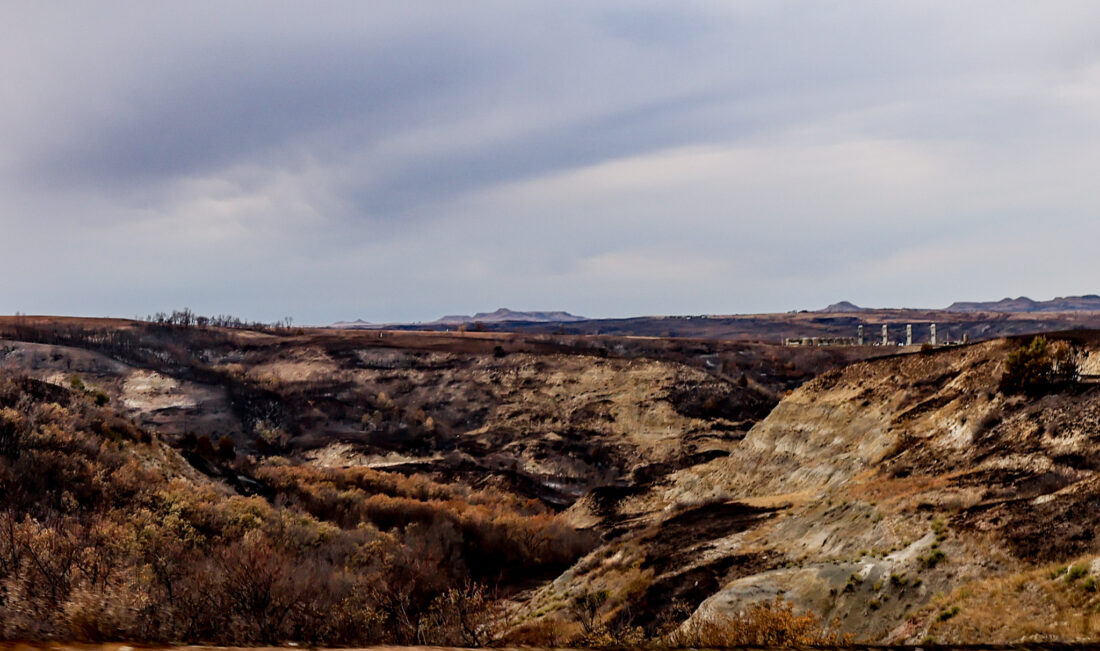
The Bear Den Fire scorched land in the Mandaree area. This photo was taken by Karen LoneFight on Friday, Oct. 11, 2024.
“And he goes, “It’s all I got left,” Jacobson said. “We got lucky and were able to hold that.”
An aerial attack on the fire saved the day for many residents.
National Guard Black Hawk helicopters took flight to provide aerial support with water buckets for the firefighting teams on the ground at both the Bear Den fire near Mandaree and a fire in the Grassy Butte area, according to the Dec. 31, 2024, edition of The Minot Daily News. Crews on the ground saved the Mandaree community, but the Bear Den fire, estimated to have burned more than 25,000 acres, destroyed two primary residences and numerous outbuildings.
Two heavy air tankers came from Montana to dump fire retardant on the wildfire in the rugged terrain near Mandaree, and two scooper planes from Bridger Aerospace in Montana dumped water while the Civil Air Patrol did photography in the Bear Den area, according to state and tribal information.
Ryan Melin, fire management officer with the North Dakota Forest Service, was quoted in The Minot Daily News’ Dec. 31 edition, saying “I’ve fought fires for 27 years across the nation, including internationally, and can honestly say I’ve never seen anything like this.”
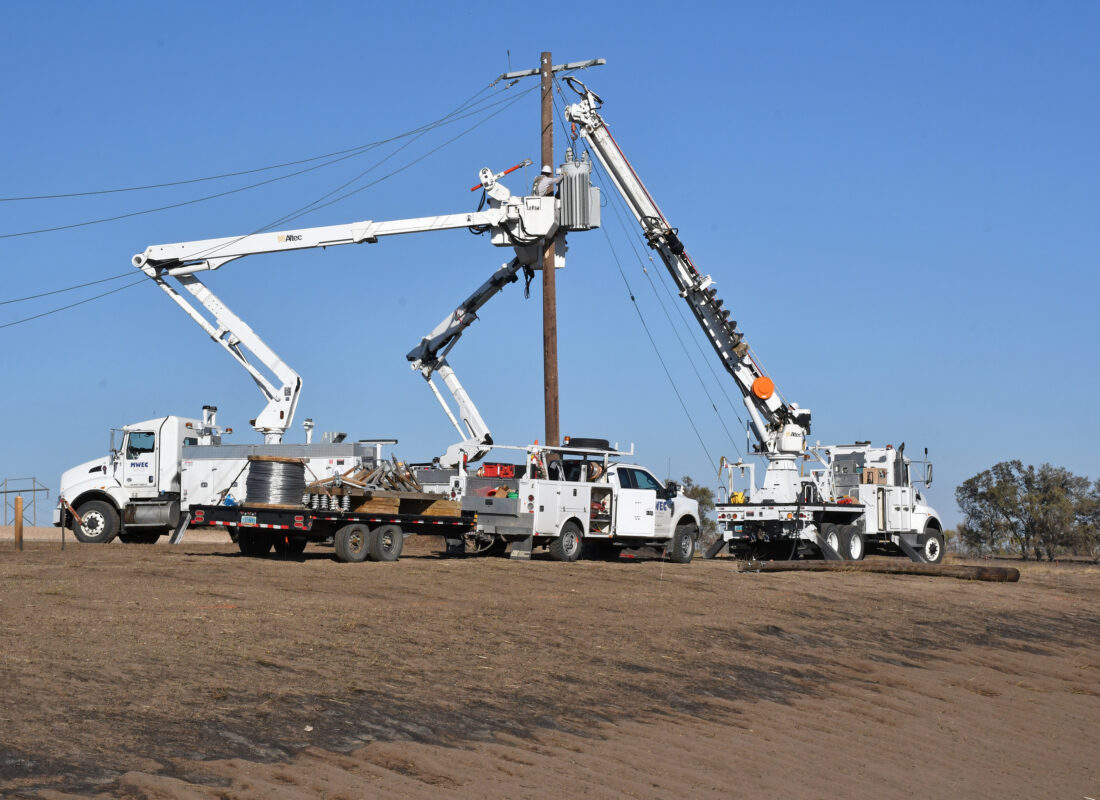
Numerous pole crews were out in force the day after fire tore through the Ray-Tioga area. A Mountrail-Williams Electric Cooperative construction crew replaces large poles that burned in the wildfires three miles west of Ray, alongside U.S. Highway 2’s west lane. Hundreds of poles were in need of replacement. Photo by Roger Riveland.
Emergency and first responders featured in the video were amazed by the extent of the fires but also by the citizens’ response – by the farmers coming with equipment to create fire breaks to help their neighbors and by the water haulers and companies with dozers who showed up. Communities rallied to provide food for the firefighters, and not just sandwiches but hearty meals such as steak dinners and home-cooked lasagna.
Electric cooperatives, contractors and neighboring cooperatives came together to restore power to members following the wildfires, The Minot Daily News reported. The North Dakota Stockmen’s Association and its foundation launched the Out of the Ashes Wildfire Disaster Relief Program to help producers. ExxonMobil presented the organizations with $100,000 to support the cause.
As of Oct. 23, 2024, the NDDES reported, all wildfires in North Dakota finally had been fully contained. The fires burned more than 118,000 acres, according to the Governor’s Office.
The state fire marshal released a report in November identifying the cause of two of the wildfires. The Midnight Run fire near Keene and the Dinwoodie fire near New Town, which ignited in the dry conditions on Oct. 5, both were determined to be caused by flares at oil and gas wells operated by ConocoPhillips and Hess Corp. The fires ignited just hours before state regulators asked oil operators to voluntarily shut down oil and gas wells in areas with high fire danger, according to The Minot Daily News report.
Justin Messner, recovery chief at NDDES, said the state had applied for a Fire Management Assistance Grant (FMAG) through the Federal Emergency Management Agency, which was approved to allow federal resources to come in and help fight the Elkhorn and Bear Den fires.
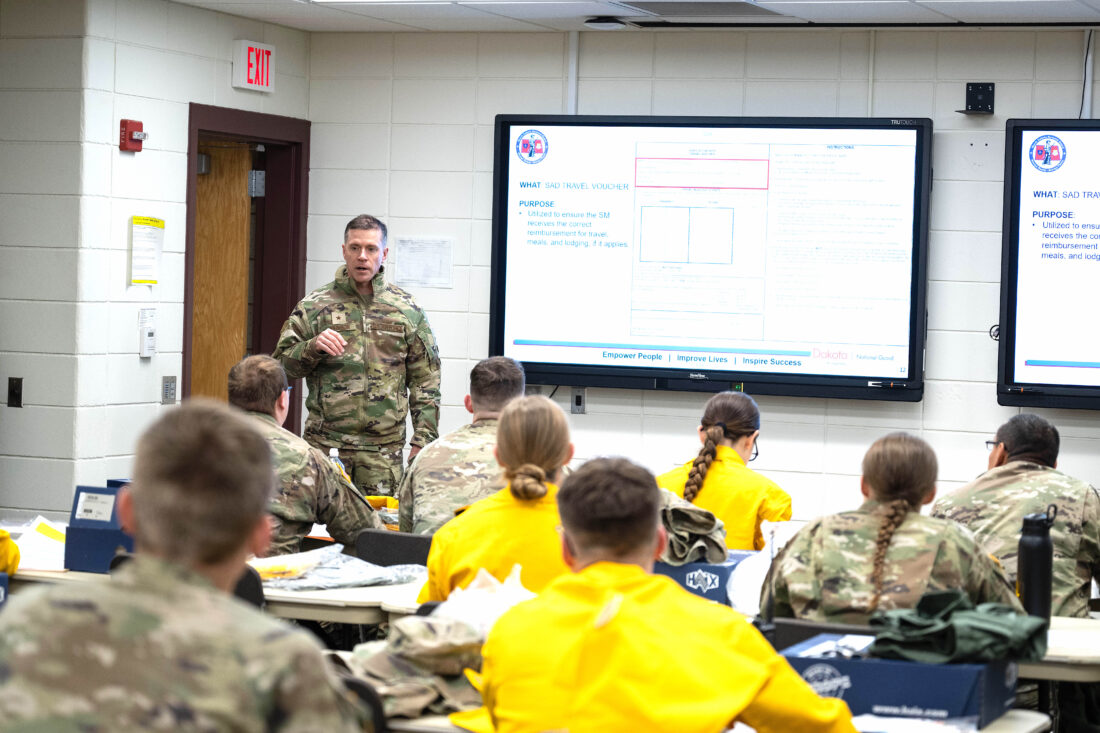
A North Dakota National Guard member prepares to head to Mandaree. Soldiers and airmen were in processed for state active duty on Sunday, Oct. 6, 2024, at Fraine Barracks in Bismarck to fight fires in western North Dakota. U.S. Army National Guard photo by Staff Sgt. Samuel J. Kroll.
“That was the first time we’d ever gotten FMAG approved in the state of North Dakota for an uncontrollable fire,” Messner said.
Messner noted NDDES, the North Dakota Forest Service and fire departments already had developed relationships that prepared them to work together when faced with a need for an all-out response.
“There was a good coordination happening among all those different entities to make sure that when wildfires do happen, which unfortunately happens quite a lot – especially in a rural area and where we’ve had drought issues – that they’re ready to go, that they’re all on the same page, that they’re all able to coordinate and rapidly respond to the event. I feel like before that event and after that event, we’ve kept those relationships going and that readiness level up to date,” he said.
Gov. Kelly Armstrong and Lt. Gov. Michelle Strinden recently announced Governor’s Awards for Excellence in Public Service, giving the Roaming Bison Award to the October Wildfire Unified Command for coordinating the efforts of more than 15 agencies that worked to protect residents and communities from historic wildfires. The award recognizes innovation, teamwork and citizen focus.
If there is an area for improvement highlighted by last October’s wildfire experience, it is to request the FMAG earlier, Messner said. However, he acknowledged the difficulty that exists in assessing the need for a FMAG when crews are deep in the trenches and there’s little opportunity to stop and make those assessments.
Post-event, the state requested and received a presidential order for federal disaster assistance.
“Once the wildfires were finally extinguished and we were able to get a damage assessment done, we identified that not only was there a ton of costs related to the response, there was also a lot of infrastructure damage, especially to electrical infrastructure in both Williams County and McKenzie County,” Messner said.
The FMAG and disaster declaration came together into one assistance package. At this point, reimbursement requests under the disaster program have totaled about $6.2 million, Messner said. It included a $2.8 million reimbursement released to Mountrail-Williams Rural Electric Cooperative Sept. 24.
Tribal assistance also came through the Bureau of Indian Affairs. Additionally, individuals turned to private insurance and federal farm programs for financial help.
Williams County Extension Agent Kelly Leo said pasture recovery has been encouraging given the damage that existed.
“It was as good as could be expected as far as our recovery time went because we did get some rain and that was very helpful,” she said. “I would think our production was about 60-70 percent of normal.”
Things were not looking good initially, though. Leo said the soil had a crust that shed water. Grasses that grew were short, sparse and weak.
However, there was a good amount of hay in the area and there were lease offers from landowners who might not have previously leased grassland, Leo said.
McKenzie County Extension Agent Ryan Odenbach echoed Leo’s assessment in describing the recovery of grasslands in his county.
“For the most part, producers had an OK year for grass growth,” he said, “having decent precipitation at times. Especially that May rain that occurred, where we got about five to six inches, just really transformed some of that.”
Leo said pastures could make a nearly full recovery in a few more years as organic matter rebuilds. The same isn’t true of farmland, which could take at least a few decades to renew its microbial makeup, she said. High winds eroded the land, leaving topsoil in drifts that were difficult to redistribute back onto the fields.
“They lost some pretty valuable soil that’s taken them years to build,” Leo said. “There’s still a lot of topsoil in ditches … We’re not going to get that back.”
The extent of the impact on crop production hasn’t been determined, but soil scientists are researching and will continue to research in coming years to assess the recovery rate, she said.
“We don’t have a lot of data on wildfire recovery,” she said. “This is an unfortunate event that, hopefully, will lead to some good information for the future.”
Odenbach added community support has been strong for those who experienced losses from the fires. Still, recovery is challenging, he said, citing one rancher for whom last year’s wildfire was just the latest of multiple times he’s had to replace fences due to fire.
“It’s not easy, but guys are impressively resilient here and impressively community-oriented,” he said. “It is something that is a definite strength of the area.”
- Nicole Koch and William Allen look over her grandfather Holte’s fire-ravaged farmstead mid-way between Tioga and Ray on Monday, Oct. 7, 2024. The ruins in the foreground were his new modular home, and an older remodeled house stood where the fire-scorched chimney still stands near the pine tree on the right side of the photo. Photo by Roger Riveland.
- A hopper bottom bin full of safflower burned late into the evening three miles west of Ray on Monday, Oct. 7, 2024. The bin, belonging to Tom Wheeler, burns while he and others auger out the contents to save the good grain. The Ray Fire Department stands by to extinguish the fire in the bin once the good grain is removed. The fire was believed to have started by embers entering through the vents on the bin. Photo by Roger Riveland.
- Fire burns acreage near Arnegard on Saturday, Oct. 5, 2024. Photo courtesy Arnegard Fire Protection District and Badlands Search & Rescue Service.
- The Bear Den Fire scorched land in the Mandaree area. This photo was taken by Karen LoneFight on Friday, Oct. 11, 2024.
- Numerous pole crews were out in force the day after fire tore through the Ray-Tioga area. A Mountrail-Williams Electric Cooperative construction crew replaces large poles that burned in the wildfires three miles west of Ray, alongside U.S. Highway 2’s west lane. Hundreds of poles were in need of replacement. Photo by Roger Riveland.
- A North Dakota National Guard member prepares to head to Mandaree. Soldiers and airmen were in processed for state active duty on Sunday, Oct. 6, 2024, at Fraine Barracks in Bismarck to fight fires in western North Dakota. U.S. Army National Guard photo by Staff Sgt. Samuel J. Kroll.

